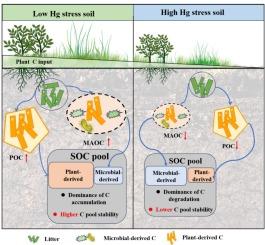低汞和高汞污染土壤中碳加工和稳定途径的对比
IF 6.6
1区 农林科学
Q1 SOIL SCIENCE
引用次数: 0
摘要
植物源输入和微生物过程之间的相互作用控制着土壤有机碳(SOC)动态。环境污染,特别是重金属胁迫,破坏了植物输入和微生物活动,从而改变了土壤碳源和转化过程。然而,微生物和植物源碳对有机碳积累的具体贡献以及汞等污染物胁迫下碳固存的潜在机制尚不清楚。在这项研究中,我们收集了19个不同汞胁迫水平下的土壤样本,并使用氨基糖和木质素酚作为生物标志物,量化了微生物和植物来源的坏死块。在高汞胁迫(HgH)下,有机碳池大小(包括矿物相关有机碳和颗粒有机碳)均有所减小。此外,使用基于Hill数多功能框架的持久性指数评估,HgH的SOC稳定性明显较低,表明碳持久性较低。此外,土壤有机碳库的来源组成在不同的汞水平上存在差异,在HgH土壤中,植物来源的碳含量较低,微生物来源的碳含量较高,表明存在一种补偿模式。傅里叶变换离子回旋共振质谱分析揭示了低、高汞污染土壤有机碳封存和积累途径的差异。在高汞土壤中,以降解为主的途径(即启动效应)占主导地位,而在低汞土壤中,以积累驱动的途径(即埋藏效应)占主导地位。这些发现强调了考虑污染引起的碳循环过程变化的重要性。本文章由计算机程序翻译,如有差异,请以英文原文为准。

Contrasting carbon processing and stabilization pathways in low- and high-mercury contaminated soils
The interplay between plant-derived inputs and microbial processes govern soil organic carbon (SOC) dynamics. Environmental contamination, particularly heavy metal stress, disrupts both plant input and microbial activity, thereby altering soil carbon sources and transformation processes. However, the specific contributions of microbial- and plant-derived carbon to SOC accumulation and the underlying mechanisms of carbon sequestration under contaminant stress, such as mercury (Hg), remain unclear. In this study, we collected 19 soil samples under varying Hg stress levels and quantified microbial- and plant-derived necromasses using amino sugars and lignin phenol as biomarkers. The SOC pool size, including both mineral-associated and particulate organic C decreased under high Hg stress (HgH). Additionally, SOC stability, evaluated using a persistence index based on the Hill number multifunctionality framework, was significantly lower for HgH, indicating lower carbon persistence. Furthermore, the source composition of the SOC pool differed across Hg levels, with lower plant-derived C and higher microbial-derived C observed in HgH soil, indicating a compensatory pattern. Fourier transform ion cyclotron resonance mass spectrometry analysis revealed contrasting SOC sequestration and accumulation pathways in low- and high-Hg-contaminated soils. In HgH soils, a degradation-dominated pathway (i.e., priming effect) prevailed, whereas an accumulation-driven pathway (i.e., entombing effect) dominated in low-Hg soils. These findings underscore the importance of considering pollution-induced shifts in carbon cycling processes.
求助全文
通过发布文献求助,成功后即可免费获取论文全文。
去求助
来源期刊

Geoderma
农林科学-土壤科学
CiteScore
11.80
自引率
6.60%
发文量
597
审稿时长
58 days
期刊介绍:
Geoderma - the global journal of soil science - welcomes authors, readers and soil research from all parts of the world, encourages worldwide soil studies, and embraces all aspects of soil science and its associated pedagogy. The journal particularly welcomes interdisciplinary work focusing on dynamic soil processes and functions across space and time.
 求助内容:
求助内容: 应助结果提醒方式:
应助结果提醒方式:


